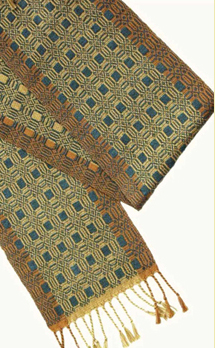| MAIN | ABOUT PO | ANNE HUNTINGTON WEAVING | ANNE HUNTINGTON PAINTING | GALLERY ARTISTS/ PAST EXHIBITS | CONTACT |
Weaving dates back thousands of years, was developed independently all over the world, is done on many different types of looms, and the basic principal is simple and unchanging. It is the interlacing of two sets of threads: the warp, which is a bundle of threads that lie parallel to each other and are fixed to the loom, and the weft, a continuous thread which is passed through the shed, or opening, made when some of the warp threads are lifted. In plain weave, the simplest of weaves, every other warp thread is lifted to make the first shed. The weft is inserted, the shed closes, and the opposite set of warp yarns lift, locking the weft thread in place. The next weft is inserted and the action is repeated until the desired length is woven.
This hardly tells the story. The craft of weaving actually offers what I believe is infinite variation, in the structure of the weave which can be very complex, in density and texture, the materials used, color - all elements that work in conjunction with each other to make a length of cloth.
I began weaving on a floor loom in 1984. Prior to that I had done other types of craftwork, but fiber appealed to me the most. Looms had always intrigued me and I took a weaving course during my last semester in college. (Wisely waiting. It would have been a major distraction.) When the semester ended I bought a loom, some yarn, and Marguerite Davison's "A Handweaver's Pattern Book" and I got to work.
Here, roughly, is what I do: I plan the warp on graph paper, choose the yarns, wind the warp, dress the loom (which is everything involved in putting the warp on the loom, threading it, tying up the treadles, etc.) experiment with different weft yarns and treadling sequences, and then weave, usually making 8 to 10 scarfs per warp. I cut the pieces off, fringe the ends, handwash and iron the finished pieces. I generally use a cotton warp for it's strength, feel, drape, and the fact that it holds its shape (some yarns stretch over time.) I sometimes add sections of smooth rayon. For the weft I have several choices: 50/50 wool-silk, merino wool, cotton, bamboo (which is very soft, almost silky), and rayon.
Weaving takes a lot of time. Every step requires concentration and labor, some of it tedious. The more you weave the better you can envision what the final piece might look like, but in some sense you are working on a hunch. You can't see what you're making until the actual weaving begins. There is a truly delightful moment when you finally do begin and your cloth, with all its beautiful intricacies, suddenly comes to life.
